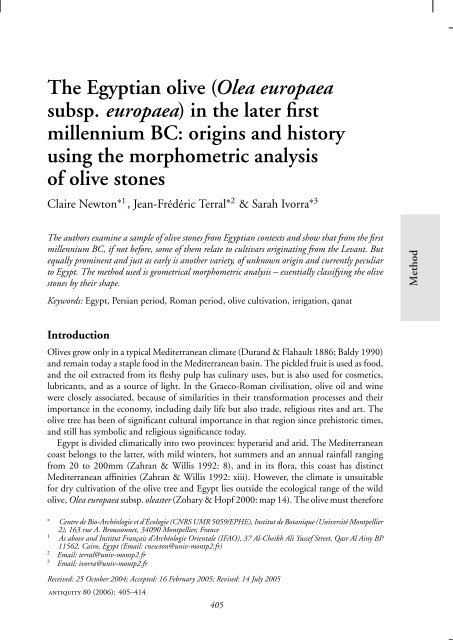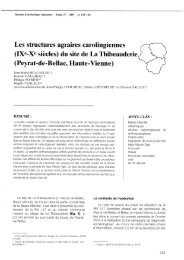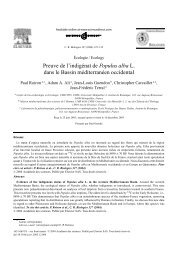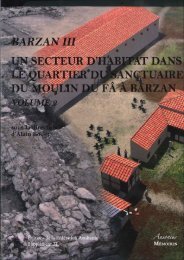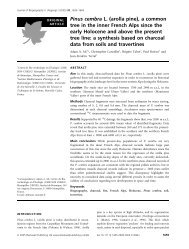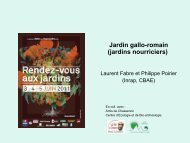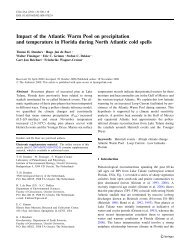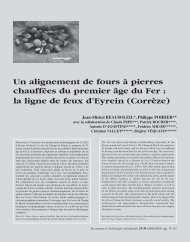The Egyptian olive (Olea europaea subsp ... - ResearchGate
The Egyptian olive (Olea europaea subsp ... - ResearchGate
The Egyptian olive (Olea europaea subsp ... - ResearchGate
Create successful ePaper yourself
Turn your PDF publications into a flip-book with our unique Google optimized e-Paper software.
<strong>The</strong> <strong>Egyptian</strong> <strong>olive</strong> (<strong>Olea</strong> <strong>europaea</strong><br />
<strong>subsp</strong>. <strong>europaea</strong>) in the later first<br />
millennium BC: origins and history<br />
using the morphometric analysis<br />
of <strong>olive</strong> stones<br />
Claire Newton ∗1 , Jean-Frédéric Terral ∗2 & Sarah Ivorra ∗3<br />
<strong>The</strong> authors examine a sample of <strong>olive</strong> stones from <strong>Egyptian</strong> contexts and show that from the first<br />
millennium BC, if not before, some of them relate to cultivars originating from the Levant. But<br />
equally prominent and just as early is another variety, of unknown origin and currently peculiar<br />
to Egypt. <strong>The</strong> method used is geometrical morphometric analysis – essentially classifying the <strong>olive</strong><br />
stones by their shape.<br />
Keywords: Egypt, Persian period, Roman period, <strong>olive</strong> cultivation, irrigation, qanat<br />
Method<br />
Introduction<br />
Olives grow only in a typical Mediterranean climate (Durand & Flahault 1886; Baldy 1990)<br />
and remain today a staple food in the Mediterranean basin. <strong>The</strong> pickled fruit is used as food,<br />
and the oil extracted from its fleshy pulp has culinary uses, but is also used for cosmetics,<br />
lubricants, and as a source of light. In the Graeco-Roman civilisation, <strong>olive</strong> oil and wine<br />
were closely associated, because of similarities in their transformation processes and their<br />
importance in the economy, including daily life but also trade, religious rites and art. <strong>The</strong><br />
<strong>olive</strong> tree has been of significant cultural importance in that region since prehistoric times,<br />
and still has symbolic and religious significance today.<br />
Egypt is divided climatically into two provinces: hyperarid and arid. <strong>The</strong> Mediterranean<br />
coast belongs to the latter, with mild winters, hot summers and an annual rainfall ranging<br />
from 20 to 200mm (Zahran & Willis 1992: 8), and in its flora, this coast has distinct<br />
Mediterranean affinities (Zahran & Willis 1992: xiii). However, the climate is unsuitable<br />
for dry cultivation of the <strong>olive</strong> tree and Egypt lies outside the ecological range of the wild<br />
<strong>olive</strong>, <strong>Olea</strong> <strong>europaea</strong> <strong>subsp</strong>. oleaster (Zohary & Hopf 2000: map 14). <strong>The</strong> <strong>olive</strong> must therefore<br />
∗<br />
Centre de Bio-Archéologie et d’Écologie (CNRS UMR 5059/EPHE), Institut de Botanique (Université Montpellier<br />
2), 163 rue A. Broussonnet, 34090 Montpellier, France<br />
1<br />
As above and Institut Français d’Archéologie Orientale (IFAO), 37 Al-Cheikh Ali Yussef Street, Qasr Al Ainy BP<br />
11562, Cairo, Egypt (Email: cnewton@univ-montp2.fr)<br />
2<br />
Email: terral@univ-montp2.fr<br />
3<br />
Email: ivorra@univ-montp2.fr<br />
Received: 25 October 2004; Accepted: 16 February 2005; Revised: 14 July 2005<br />
antiquity 80 (2006): 405–414<br />
405
Origins and history of the <strong>Egyptian</strong> <strong>olive</strong><br />
Figure 1. Map of the localities and archaeological sites mentioned in the text. <strong>The</strong> main regions of <strong>olive</strong> production in historic<br />
and modern times in Egypt (after Meeks 1993) are also indicated.<br />
have been introduced from elsewhere, as is endorsed by etymology: its <strong>Egyptian</strong> name is<br />
borrowed from a Semitic language (Meeks 1993). Today, <strong>olive</strong>s are cultivated on a small<br />
scale all over the country, and on a larger scale in a few restricted areas (Figure 1). In all<br />
cases, their cultivation requires irrigation.<br />
<strong>The</strong> date of the beginning of oleiculture in Egypt is subject to debate (Serpico & White<br />
2000: 398-9). Although there is evidence for the consumption of <strong>olive</strong>s and possibly of<br />
<strong>olive</strong> oil at least since the New Kingdom (c. 1550-1070 BC), the products may have been<br />
imported. In neighbouring Levant, <strong>olive</strong> use and probably cultivation, if not domestication,<br />
are attested much earlier, during the Early Bronze Age (c . 3300-2200 BC) (Liphschitz<br />
et al. 1991; Zohary & Hopf 2000: 149). Its cultivation could have been introduced from<br />
406
Claire Newton, Jean-Frédéric Terral & Sarah Ivorra<br />
the Levant to Crete and Greece during the Early Bronze Age, then to southern Italy (Brun<br />
2003: 128). <strong>The</strong> spread of oleiculture to northern Africa and Spain probably followed the<br />
Phoenician expansion (Brun 2003).<br />
To date, the oldest <strong>olive</strong> remains found in Egypt are charred stones from Thirteenth<br />
Dynasty Memphis (Kom el-Rabi’a, c . 1802-1640 BC) (Murray 2000: 610) and from the<br />
late Second Intermediate period Avaris in the Nile delta (Tell el-Dab’a, Thanheiser 2004,<br />
in press). <strong>The</strong>y probably represent imported fruit from the Eastern Mediterranean (Syro-<br />
Palestine), with which <strong>Egyptian</strong> trade was flourishing. <strong>The</strong> earliest <strong>olive</strong> wood identifications<br />
date to the New Kingdom (Asensi Amorós 2003). Stones, leaves and wood are found<br />
regularly from the New Kingdom onward (De Vartavan & Asensi Amorós 1997: 183-6).<br />
<strong>The</strong> leaves were used in garlands found in tombs from the New Kingdom, especially in the<br />
<strong>The</strong>ban area (Greiss 1966; Germer 1988, 1989), and the wood was used for the manufacture<br />
of coffins (Grosser et al. 1992). Finds from the workers’ villages of El-Amarna (Renfrew<br />
1985: 188) and Deir el-Medina (Bell 1982: 153) attest to their local consumption, although<br />
<strong>olive</strong>s must have been an occasional and luxurious food item.<br />
Eastern Mediterranean trade in <strong>olive</strong>s is demonstrated by the find of thousands of <strong>olive</strong>s<br />
and <strong>olive</strong> stones from a Late Bronze Age (late fourteenth century BC) shipwreck at Ulu Burun<br />
off the southern coast of Turkey, including a single deposit of more than 2500 stones in a<br />
Canaanite jar (Haldane 1993: 352). <strong>The</strong> ship, which sank during the Eighteenth Dynasty<br />
of the New Kingdom, also transported terebinth resin, identified also at the <strong>Egyptian</strong> New<br />
Kingdom site of El-Amarna (Haldane 1993). Iconographic and textual evidence also point<br />
toward the cultivation of the <strong>olive</strong> tree in Egypt during the New Kingdom (Meeks 1993).<br />
<strong>The</strong> texts also indicate that the produce was delivered almost exclusively to the temples and<br />
to the royal house (Haldane 1993).<br />
In Graeco-Roman times, the two main regions of cultivation for the <strong>olive</strong> tree would have<br />
been around Memphis, the Fayum and around <strong>The</strong>bes (Serpico & White 2000: 401). A<br />
document dating to 255 BC gives us an interesting clue concerning the varieties cultivated<br />
in Ptolemaic times; Apollonios, owner of an estate located in the Fayum, recommends<br />
grafting of <strong>olive</strong>s to his employee Zenon, in order to introduce Greek varieties to replace<br />
the <strong>Egyptian</strong> ones (P. Cairo Zen. 59184; Brun 2003: 128). Other documents from the<br />
Zenon archives mention several varieties grown in Egypt, in particular one ‘from Chios’<br />
(Brun 2003: 124). At the time that Pliny writes (first century AD), 15 varieties are recorded<br />
(Natural History XV: 15-7). Five of these bear large fruit suitable for pickling, including an<br />
<strong>Egyptian</strong> one. Finds of numerous <strong>olive</strong> presses at late Roman Akoris (third-fourth centuries<br />
AD), Middle Egypt, provide archaeological evidence for large-scale <strong>olive</strong> oil production at<br />
that time (Tsujimara 1995).<br />
Finds from Ptolemaic and Roman period sites include wood (Asensi Amorós 2001), and<br />
all types of remains from settlement contexts in the oases (Thanheiser 1999; Wuttmann<br />
et al. 1998). For the Roman period, <strong>olive</strong> remains are also found at sites where they could<br />
not have been grown, such as Berenike on the Red Sea coast (Cappers 1998) and praesidia<br />
(fortified stations) on the roads linking the Nile valley to the Red Sea ports (this study;<br />
Tengberg in prep).<br />
In spite of its social and economic importance, the history of <strong>olive</strong> cultivation in the<br />
eastern Mediterranean, and in Egypt in particular, is not known in any detail. Where and<br />
Method<br />
407
Origins and history of the <strong>Egyptian</strong> <strong>olive</strong><br />
when were the <strong>olive</strong>s introduced and adapted for cultivation, and which varieties were<br />
selected? <strong>The</strong> purpose of this paper is to present the results of recent research on the origins<br />
and uses of <strong>olive</strong> varieties in Egypt in later prehistory, and to examine the implications for<br />
political contact and trade. <strong>The</strong> method used is a morphometrical classification of the <strong>olive</strong><br />
stones, both from ancient and modern contexts.<br />
Materials and method<br />
<strong>The</strong> stones selected for analysis come from two main sites; ’Ayn-Manâwir in the south of the<br />
Kharga Oasis and Al-Zarqâ’/Maximianon in the Eastern Desert (Figure 1). ’Ayn-Manâwir<br />
is a large site located at the southern tip of the Kharga depression in the Western desert. It<br />
comprises an elaborate complex of underground water-collecting galleries (qanâts) dug into<br />
the hill and used for irrigating the slopes and plain surrounding the hill. <strong>The</strong> provenances<br />
of the <strong>olive</strong> stones are: a Persian period settlement site (MMA) dated by pottery to the<br />
fifth century BC (Thiers 2000a), a settlement site (MMS) dating to the Roman Early and<br />
Middle Imperial periods, first and second centuries AD (Thiers 2000b), and contexts related<br />
to Roman qanâts, such as the orchards/gardens MQ5d (Thiers 1998) and MQ10 (Newton<br />
et al. 2006), both dated to the Roman period (Thiers 1998: 23). Two stones come from the<br />
Persian period settlement, 45 from the Roman contexts.<br />
Al-Zarqâ’/Maximianon, is a Roman praesidium (fortified station) on the road from Koptos<br />
(modern Qift) to Myos Hormos (modern Quseir) (Figure 1). <strong>The</strong> eight stones all come<br />
from the trash dump of that building. <strong>The</strong> strata in which they were found are dated<br />
archaeologically (ceramic material, coins and ostraca) to the second half of the first century<br />
AD until the last quarter of the second century AD – beginning of the third century AD<br />
(Brun & Reddé 2003).<br />
At the same time, fruit from three modern <strong>Egyptian</strong> varieties were collected in October<br />
2003: Baladi, a cultivated variety grown in the south of the Kharga Oasis, collected in Bâris,<br />
Azizi and Toffahi, two varieties grown in the Nile valley at Sahel Silim near Assiut (Figure 1).<br />
It seems that the Toffahi variety can be identified with another variety called Fayumi and<br />
grown in the Fayum. Toffahi is also known to be grown in Syria (NPGS 2003). Ninety<br />
specimens of these modern <strong>Egyptian</strong> <strong>olive</strong> stones were added to a reference collection of<br />
<strong>olive</strong> stones from various Mediterranean countries (Terral et al. 2004) that comprises 1500<br />
stones, 330 wild and 1170 cultivated. This reference collection is kept in Montpellier, at<br />
the Centre de Bio-Archéologie et d’Écologie.<br />
<strong>The</strong> size of fruit and seed varies according to its agricultural status (uncultivated or<br />
cultivated) and the taxonomical status of the plant (<strong>subsp</strong>ecies or botanical variety), but also<br />
on a number of other ecological, anthropogenic, pathological and developmental variables.<br />
Since the whole fruit is not usually available in archaeological contexts, the method of<br />
classification used was geometrical morphometry (Bookstein 1991; Marcus et al. 1996),<br />
which consists of characterising the geometry (shape) of a structure, independently from its<br />
dimension (size). Factors connected to the developmental and environmental parameters<br />
cause morphological variability, also called phenotypic plasticity. <strong>The</strong> variation in the shape<br />
of the <strong>olive</strong> stone (the ‘plasticity of its morphological character’) can be explained by three<br />
main components, genetic, environmental and ontogenetic (growth and development).<br />
408
Claire Newton, Jean-Frédéric Terral & Sarah Ivorra<br />
Table 1. Allocation of archaeological stones to extant morphological groups defined by UPGMA<br />
Archaeological<br />
Probability of<br />
Site Cultural period context N Morphotype allocation<br />
AM Persian period 2 III 0.62<br />
<strong>Egyptian</strong> 0.70<br />
Roman period MMS3 11 III (n = 3) 0.64-0.80<br />
<strong>Egyptian</strong> (n = 5) 0.62 p 0.96<br />
unclassified (n = 3)<br />
MMS6 1 unclassified<br />
MMS19 9 III (n = 4) 0.62 p 0.74<br />
<strong>Egyptian</strong> (n = 4) 0.62 p 0.89<br />
unclassified (n = 1)<br />
MMS23 5 III (n = 2) 0.71-0.85<br />
<strong>Egyptian</strong> (n = 1) 0.68<br />
unclassified (n = 2)<br />
MMS47 2 III 0.72<br />
unclassified<br />
MMS51 4 <strong>Egyptian</strong> (n = 1) 0.74<br />
unclassified (n = 3)<br />
MMS61 8 III (n = 1) 0.73<br />
<strong>Egyptian</strong> (n = 4) 0.63 p 1.00<br />
unclassified (n = 3)<br />
MMS523 2 <strong>Egyptian</strong> 0.98<br />
unclassified<br />
MQ 3 <strong>Egyptian</strong> (n = 2) 0.85-0.98<br />
unclassified<br />
Z Roman period 8 <strong>Egyptian</strong> (n = 4) 0.87 p 1.00<br />
III-IV-V (n = 2) 0.62-0.66<br />
unclassified (n = 2)<br />
Method<br />
Stones of similar shape should have biogeographical or historical connections. <strong>The</strong> results<br />
should nevertheless be interpreted with caution, because morphology is currently considered<br />
as the expression of systems of genes that are often unknown.<br />
Geometrical morphometric analyses were carried out on <strong>olive</strong> stones following the<br />
protocols previously developed by Terral et al. (2004). Each record involved the image<br />
capture of the stone and its reduction to a standardised outline. <strong>The</strong> outlines were compared<br />
using multivariate statistical analyses: CVA (Canonical Variate Analysis) andUPGMA<br />
(Unweighed Pair Group Method with Arithmetic mean). <strong>The</strong> archaeological specimens were<br />
then statistically clustered with the newly augmented reference collection (see above).<br />
This analysis showed up morphological relationships between ancient and modern <strong>olive</strong><br />
populations and cultivars, and situated the archaeological stones (N = 55) with those of<br />
nearest similarity (Table 1 and Figure 2).<br />
Results<br />
In comparison to the widely provenanced varieties in the reference collection, the<br />
three modern <strong>Egyptian</strong> cultivars constitute an original cluster. <strong>The</strong>y are themselves<br />
409
Origins and history of the <strong>Egyptian</strong> <strong>olive</strong><br />
Figure 2. Cluster analysis (UPGMA) based on the minimum Mahalanobis distances among each <strong>olive</strong> group including<br />
modern wild populations and cultivars.<br />
morphologically related, but very dissimilar to other groups (Figure 2). Within this ‘<strong>Egyptian</strong><br />
group’, the morphological similitude between Azizi and Toffahi may indicate that these two<br />
cultivars correspond in fact to a single cultivated variety. This fact constitutes an example<br />
of synonymy common in the case of cultivated varieties, and related to distinct cultivation<br />
regions.<br />
<strong>The</strong> stones from archaeological contexts were identified as belonging either to the <strong>Egyptian</strong><br />
group (23) or to Group III (14), composed of Israeli wild populations, one Israeli cultivar<br />
and three French cultivars (Table 1). <strong>The</strong> examples were from Persian or Roman period<br />
contexts. <strong>The</strong> remaining eighteen out of the 55 specimens could not be identified (Table 1).<br />
410
Claire Newton, Jean-Frédéric Terral & Sarah Ivorra<br />
Discussion<br />
<strong>The</strong> <strong>olive</strong> stones found on both the archaeological sites, in both the Persian and the Roman<br />
periods, are related to two distinct modern groups (Table 1). One group is represented by<br />
the modern <strong>Egyptian</strong> cultivars, which themselves form a distinct group from the rest of the<br />
reference material (Figure 2). This shows that there has been continuity in the cultivation<br />
of this group of cultivars from at least the middle of the last millennium BC. In the present<br />
state of research, this could mean that these cultivars evolved and were selected in Egypt,<br />
or that the cultivar that was first introduced in Egypt has not yet entered the reference<br />
data base. Genetic data from Toffahi has shown the presence of a specific marker (ME2<br />
mitotype) (Besnard & Bervillé 2000; Besnard et al. 2002) common in some cultivars such<br />
as Amygdalolia (Greece), Zaity (Syria), probably originated from an ancestral domestication<br />
centre located in the Eastern Mediterranean Basin. However, the origin of this group<br />
currently remains unknown.<br />
<strong>The</strong> second group is related to wild types and cultivars that could have originated in the<br />
Levant region (Syro-Palestine), the region where the oldest traces of intensive <strong>olive</strong> use and<br />
perhaps cultivation have so far been found (Liphschitz et al. 1991). This implies that <strong>olive</strong>s<br />
of this variety were perhaps first imported as fruit or oil into Egypt and later introduced as<br />
cultivars. Trade relations between the two regions are older than the Pharaonic period, and<br />
they have been under common rule several times during their history.<br />
<strong>The</strong> presence of <strong>olive</strong>s from both areas of origin during the Persian period raises the<br />
question of whether they were introduced at that time. Briant (1997: 89) suggests that the<br />
Persian authorities could have given fiscal incentive to <strong>Egyptian</strong> farmers to settle and dig<br />
qanâts (underground water-collecting galleries) in the region, leaving them free to arrange<br />
the details of the irrigation regulations. That could also have been the case for the selection<br />
of crops to grow on the irrigated land. <strong>The</strong> choices would thus be in accordance with local<br />
constraints rather than with a distant central power. However, <strong>olive</strong> remains are still scarce<br />
for this period at ’Ayn-Manâwir (fragments, 3 complete stones), although that may be due<br />
to the mode of preservation, i.e. exclusively charred. No mention is made of any <strong>olive</strong><br />
product or of <strong>olive</strong> cultivation on the Persian period ostraca (M. Chauveau pers. comm.),<br />
and up to now no <strong>olive</strong> charcoal has been identified.<br />
Between the Persian and Roman periods, there is evidence of occupation during the<br />
Ptolemaic period, but no <strong>olive</strong> remains were found in the few samples collected (Newton<br />
2002). However, it is possible that the trees introduced presumably under Persian rule were<br />
cultivated until the Roman time of expansion of the local settlements. Grafts and/or fruit<br />
from elsewhere could also have re-introduced oleiculture in the oasis. In the Roman period<br />
there is textual evidence for the presence of <strong>olive</strong> groves and <strong>olive</strong> oil in the area of the two<br />
sites examined (P. Jand. 142; Wagner 1987: 296). <strong>The</strong> cultivation of <strong>olive</strong> trees is described<br />
on field borders, and in association with barley, grapevine, and date palms (P. Jand. 142;<br />
Bousquet & Reddé 1994: 87-8).<br />
Although Persian-period <strong>olive</strong> stones are scarce, the results show that two different varieties<br />
were grown at that time, and that the same two were still grown five centuries later, during<br />
the Roman period. <strong>The</strong> more abundant Roman material also shows that one or several more<br />
varieties were produced at that time, but it cannot yet be demonstrated whether they were<br />
Method<br />
411
Origins and history of the <strong>Egyptian</strong> <strong>olive</strong><br />
also produced in the previous period, for lack of archaeological stones. <strong>The</strong> cultivation of the<br />
same types during the two periods may indicate, either that the same trees were cultivated<br />
again with the new agricultural expansion of the region during the Roman period, and<br />
that they could have been tended to between the two periods, or that the same types were<br />
meanwhile still being cultivated in another area, perhaps even within the Kharga oasis, from<br />
which new individuals were introduced into the region of ’Ayn-Manâwir.<br />
<strong>The</strong> two identified morphotypes found at ’Ayn-Manâwir were also found at Al-Zarqâ’.<br />
Al-Zarqâ’/Maximianon is a fortified station on a road which was used as a relay for caravans<br />
transporting goods imported through a Red Sea port to the Nile valley, and other goods from<br />
the valley to the port and settlements along the road. Olives and <strong>olive</strong> oil are mentioned in<br />
the ostraca from the Roman stations along this road, as products imported from the valley<br />
(Bülow-Jacobsen 2003: 420). <strong>The</strong> <strong>olive</strong> stones found at the site probably represent varieties<br />
grown in the Nile valley.<br />
<strong>The</strong> two types therefore occur on either side of the valley, on a producer site and on a<br />
consumer site. If we consider that the <strong>olive</strong>s were imported to Al-Zarqâ’ most probably from<br />
the Nile valley, it could mean that the varieties grown in Egypt during the early Roman<br />
times were the same in the valley and in the south of the Kharga oasis. <strong>The</strong> chronological<br />
and geographical origin of these morphotypes in Egypt remains to be elucidated, through<br />
the analysis of older material from the Nile valley.<br />
Conclusion and perspectives<br />
<strong>The</strong> results from the first geometrical morphometric analyses of modern and archaeological<br />
<strong>olive</strong> stones show, on the one hand, that the modern <strong>Egyptian</strong> cultivars are significantly<br />
distinct from the rest of the reference varieties, and on the other hand, that the cultivation<br />
of these varieties dates back at least to the middle of the last millennium BC, during the<br />
first Persian rule over Egypt. <strong>The</strong> archaeological material also reveals the cultivation of other<br />
varieties, one related to modern types probably originating from the Levant, the other(s)<br />
not yet identified. <strong>The</strong> identity of the first varieties introduced in Egypt, and the further<br />
evolution of oleiculture through Pharaonic, Classical and Islamic times, need to be assessed<br />
through the analysis of additional archaeological material from diverse periods, including<br />
the first attested remains (Middle and New Kingdom).<br />
To be determined more precisely is the identity of the variety or varieties represented by<br />
the <strong>olive</strong> stones that could not be linked to any group from the present reference collection.<br />
For that purpose, we are still lacking reference material, from wild types growing in Syria,<br />
and from cultivars grown in Egypt as well as in neighbouring countries in the Eastern<br />
Mediterranean region (Israel, Lebanon, Syria, Turkey, Cyprus, Greece, Tunisia). We must<br />
therefore consider these first results as preliminary.<br />
Acknowledgements<br />
<strong>The</strong> authors would like to thank Michel Wuttmann, Hélène Cuvigny and the Ifao for allowing the study<br />
of plant macro-remains from the sites of ’Ayn-Manâwir and Al-Zarqâ’, and for providing the necessary<br />
equipment on the sites. Hamdi Hammâm Hassan, inspector for the Supreme Council of Antiquities and ’Abd<br />
El-Ghany Mohammed Ahmed from the village of Douch, are also thanked for their collaboration in collecting<br />
the reference material. Thierry Gonon helped with the processing of the photographs from ’Ayn-Manâwir.<br />
412
Claire Newton, Jean-Frédéric Terral & Sarah Ivorra<br />
<strong>The</strong> Ifao and the French Ministry of Foreign Affairs funded the archaeological missions. Michel Chauveau<br />
and Hélène Cuvigny kindly provided comments and references on textual evidence for <strong>olive</strong> in the studied<br />
sites. Dimitri Meeks kindly allowed us to use his map. This work was supported by the CNRS – GDR 2474<br />
«Morphométrie et Évolution des formes».<br />
References<br />
Asensi Amorós, V. 2001. Madera de Egipto, madera<br />
importada. I: Contribucion del estudio de la<br />
anatomia de la madera para la comprension de la<br />
civilizacion egipcia, in J. Cervello Autuori &<br />
A. Quevedo Alvarez (ed.) . . . Ir a buscar leña,<br />
Estudios dedicados al prof. Jesus Lopez: 23-32.<br />
Barcelona: Aula Aegyptiaca – Studia 2.<br />
–2003. L’étude du bois et de son commerce en Egypte:<br />
lacunes des connaissances actuelles et perspectives<br />
pour l’analyse xylologique, in K. Neumann, A.<br />
Butler & S. Kahlheber (ed.) Food, Fuel and Fields.<br />
Progress in African Archaeobotany: 177-86. Köln:<br />
Heinrich-Barth Institut.<br />
Baldy, C. 1990. Le climat de l’olivier (<strong>Olea</strong> <strong>europaea</strong><br />
L.). Ecologia Mediterranea XVI: 113-21.<br />
Bell, M. 1982. Preliminary report on the Mycenian<br />
Pottery from Deir el-Medina (1979-1980). Annales<br />
du Service des Antiquités de l’Égypte 68: 143-63.<br />
Besnard, G. & A. Bervillé. 2000. Multiple origins for<br />
Mediterranean <strong>olive</strong> (<strong>Olea</strong> <strong>europaea</strong> L. ssp.<br />
<strong>europaea</strong>) based upon mitochondrial DNA<br />
polymorphisms. Comptes Rendus de l’Académie des<br />
Sciences, Paris (Sciences de la Vie) 323: 173-81.<br />
Besnard, G., B. Khadari, P. Baradat & A. Bervillé.<br />
2002. Combination of chloroplast and<br />
mitochondrial DNA polymorphisms to study<br />
cytoplasm genetic differentiation in the <strong>olive</strong><br />
complex (<strong>Olea</strong> <strong>europaea</strong> L.). <strong>The</strong>oretical and Applied<br />
Genetics 105: 139-44.<br />
Bookstein, F.L. 1991. Morphometric tools for landmark<br />
data. Geometry and Biology. Cambridge: Cambridge<br />
University Press.<br />
Bousquet, B. & M. Reddé. 1994. Les installations<br />
hydrauliques et les parcellaires dans la région de Tell<br />
Douch, in B. Menu (ed.) Les problèmes<br />
institutionnels de l’eau en Égypte ancienne et dans<br />
l’Antiquitéméditeranéenne. Colloque AIDEA Vogüe<br />
1992. Bibliothèque d’Étude 60: 73-88. Cairo: IFAO.<br />
Briant, P. 1997. Bulletin d’Histoire Achéménide (I),<br />
Topoi. Orient-Occident, Supplément 1, Recherches<br />
récentes sur l’Empire achéménide: 5-127.<br />
Brun, J.-P. 2003. Le vin et l’huile dans la Méditerranée<br />
antique. Viticulture, oléiculture et procédés de<br />
transformation. Paris: Errance.<br />
Brun, J.-P. & M. Reddé. 2003. L’architecture des<br />
praesidia et la genèse des dépotoirs, VI. Al-Zarqâ’<br />
(Maximianon), in H. Cuvigny (ed.) La route de<br />
Myos Hormos. L’armée romaine dans le désert<br />
Oriental d’Égypte, vol. 1: 100-26. Cairo: IFAO.<br />
Bülow-Jacobsen, A. 2003. <strong>The</strong> traffic on the road and<br />
the provisioning of the stations, in H. Cuvigny<br />
(ed.) La route de Myos Hormos. L’armée romaine dans<br />
le désert Oriental d’Égypte, vol. 2: 399-426. Cairo:<br />
IFAO.<br />
Cappers, R. 1998. Archaeobotanical remains, in<br />
S. Sidebotham & W. Wendrich (ed.) Berenike ’96.<br />
Report of the Excavations at Berenika (<strong>Egyptian</strong> Red<br />
Sea Coast) and the Survey of the Eastern Desert:<br />
289-330. Leiden: Research School CNWS.<br />
De Vartavan, C. & V. Asensi Amorós. 1997. Codex<br />
of Ancient <strong>Egyptian</strong> Plant Remains. London: Triade<br />
Exploration.<br />
Durand, E. & Flahault, C. 1886. Les limites de la<br />
région méditerranéenne en France. Bulletin de la<br />
SociétéBotaniqueFrançaise, vol. 33: 24-34.<br />
Germer, R. 1988. Katalog der altägyptischen<br />
Pflanzenreste der Berliner Museen. Ägyptologische<br />
Abhandlungen 47. Wiesbaden: Harrassowitz.<br />
–1989. Die Blütenhalskragen aus RT 54. Miscellanea<br />
Aegyptologica Wolfgang Helck zum 75. Geburstag:<br />
89-96. Hamburg: Archäologisches Institut der<br />
Universität Hamburg.<br />
Greiss, E. 1966. Identification anatomique des plantes<br />
provenant de trois fouilles archéologiques. Bulletin<br />
de l’Institut d’Égypte 42-3: 17-38.<br />
Grosser, D., R. Grünwald & B. Kreissl. 1992.<br />
Holz – ein wichtiger Werkstoff im Alten Ägypten,<br />
in S. Schoske, B. Kreissl & R. Germer (ed.) Anch –<br />
Blumen für das Leben – Pflanzen im Alten Ägypten.<br />
Schriften aus der Ägyptischen Sammlung (SAS),<br />
Heft 6: 251-61. Munich: Staatliche Sammlung<br />
Ägyptischer Kunst Museum.<br />
Haldane, C. 1993. Direct evidence for organic cargoes<br />
in the Late Bronze Age. World Archaeology 24/3:<br />
348-60.<br />
Liphschitz, N., R. Gophna, M. Hartmann & G.<br />
Biger. 1991. <strong>The</strong> beginning of <strong>olive</strong> (<strong>Olea</strong><br />
<strong>europaea</strong>) cultivation in the Old World: a<br />
reassessment. Journal of Archaeological Science 18:<br />
441-53.<br />
Marcus, L.F., M. Corti, A. Loy, G.J.P. Naylor &<br />
D. Slice. 1996. Advances in Morphometrics.<br />
NATO ASI series. New York: Plenum Press.<br />
Meeks, D. 1993. Oléiculture et viticulture dans<br />
l’Égypte pharaonique, in M.-C Amouretti. & J.-P.<br />
Brun (ed.) Oil and Wine Production in the<br />
Mediterranean Area, Bulletin de Correspondance<br />
Hellénique, Supplément 26: 3-38. Athens: École<br />
Française d’Athènes.<br />
Method<br />
413
Origins and history of the <strong>Egyptian</strong> <strong>olive</strong><br />
Murray, M.A. 2000. Fruits, vegetables, pulses and<br />
condiments, in P. Nicholson & I. Shaw (ed.)<br />
Ancient <strong>Egyptian</strong> Materials and Technology: 609-55.<br />
Cambridge: Cambridge University Press.<br />
Newton, C. 2002. Environnement végétal et économie<br />
en Haute-Égypte àAdaimaauPrédynastique;<br />
Approches archéobotaniques comparatives de la<br />
Deuxième dynastie àl’époque romaine. Université<br />
Montpellier II, Montpellier. Unpublished PhD<br />
thesis.<br />
Newton, C., T. Gonon & M. Wuttmann. 2006. Un<br />
jardin d’oasis d’époque romaine à ’Ayn-Manâwir<br />
(Kharga, Égypte). BIFAO 105: 167-96.<br />
Renfrew, J. 1985. Preliminary report on the botanical<br />
remains, in B. Kemp (ed.) Amarna reports II,<br />
Occasional Publications 2: 175-90. London: Egypt<br />
Exploration Society.<br />
Serpico, M. & R. White. 2000. Oil, fat and wax, in<br />
P. Nicholson & I. Shaw (ed.) Ancient <strong>Egyptian</strong><br />
Materials and Technology: 390-429. Cambridge:<br />
Cambridge University Press.<br />
Tengberg, M. in prep. L’acquisition et l’utilisation des<br />
produits végétaux àDidymoi;Analyse<br />
archéobotanique. In the collective publication of<br />
the Didymoi praesidium.<br />
Terral, J.-F., N. Alonso, R. Buxó I Capdevila, N.<br />
Chatti, L. Fabre, G. Fiorentino, P. Marinval,<br />
G. Pérez Jordá, B. Pradat, N. Rovira, P.<br />
Alibert. 2004. Historical biogeography of <strong>olive</strong><br />
domestication (<strong>Olea</strong> <strong>europaea</strong> L.) as revealed by<br />
geometrical morphometry applied to biological and<br />
archaeological material. Journal of Biogeography 31:<br />
63-77.<br />
Thanheiser, U. 1999. Plant Remains from Kellis: First<br />
Results, in C. Hope & A. Mills (ed.) Dakhleh Oasis<br />
Project: Preliminary Reports on the 1992-1993 and<br />
1993-1994 Field Seasons: 89-93. Oxford: Oxbow.<br />
–2004. Die Pflanzenreste, in I. Hein & P. Jánosi (ed.)<br />
Tell el-Dab’a XI. Areal A/V. Siedlungsrelikte der späten<br />
2. Zwischenzeit. Mit Beiträgen von Karin Kopetzky,<br />
Louise Maguire, Christa Mlinar, Graham Philip,<br />
Andreas Tillmann, Ursula Thanheiser aund Karl<br />
Grosschmidt: 377-83. Vienna: Österreichischen<br />
Akademie der Wissenschaften.<br />
–in press. Über den Ackerbau in dynastischer Zeit.<br />
Ergebnisse der Untersuchung von Pflanzenresten<br />
aus Tell el-Dab’a, in M. Bietak et al. (ed.) Tell<br />
el-Dab’a VIII. Interdisziplinäre Studien. Vienna:<br />
Österreichischen Akademie der Wissenschaften.<br />
Thiers, C. 1998. Le bassin de régulation de la qanât<br />
Q5, in M. Wuttmann (ed.)’Ayn-Manâwir et Douch,<br />
campagne 1998. Rapport interne: 21-6.<br />
–2000a. ‘Ayn-Manâwir: l’habitat MMA, in M.<br />
Wuttmann (ed.) ’Ayn-Manâwir et Douch, campagnes<br />
1999 et 2000: 8-35.<br />
–2000b. ‘Ayn-Manâwir: l’habitat MMS, in M.<br />
Wuttmann (ed.) ’Ayn-Manâwir et Douch, campagnes<br />
1999 et 2000: 41-8.<br />
Tsujimara, S. 1995. Olive oil production in Akoris.<br />
Akoris. Report on the excavations at Akoris in<br />
Middle Egypt 1981-1992. Kyoto: Koyo Shobo:<br />
464-70.<br />
Wagner, G. 1987. Les oasis d’Égypte àl’époque grecque,<br />
romaine et byzantine d’après les documents grecs.<br />
Cairo: IFAO.<br />
Wuttmann, M., H. Barakat, B. Bousquet, M.<br />
Chauveau, T. Gonon, S. Marchand, M. Robin<br />
& A. Schweitzer. 1998. ’Ayn-Manâwîr (oasis de<br />
Kharga), Deuxième rapport préliminaire. BIFAO<br />
98: 367-462.<br />
Zahran, M. & A. Willis. 1992. <strong>The</strong> vegetation of<br />
Egypt. London: Chapman & Hall.<br />
Zohary, D. & M. Hopf. 2000. Domestication of plants<br />
in the Old World. <strong>The</strong> origin and spread of<br />
cultivated plants in West Asia, Europe and the Nile<br />
Valley. Third edition. Oxford: Oxford University<br />
Press.<br />
414


